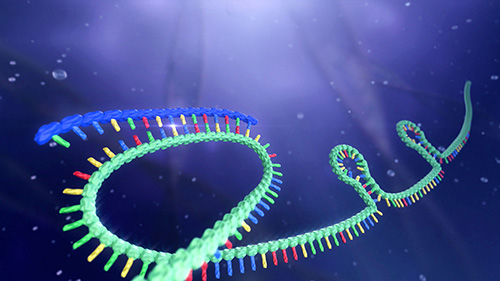“The Eterna player community may be able to come up with designs that we wouldn’t get using traditional screening methodologies for drug development,” said Michael Stone, professor of chemistry and biochemistry at UC Santa Cruz.
Eterna is an open science platform that has been engaging citizen scientists in RNA-related puzzles for over 10 years. Previous challenges have included OpenVaccine, to design a more stable mRNA vaccine against COVID-19, and OpenTB, to develop a new diagnostic device to detect tuberculosis.
Stone and his colleagues at UCSC—including molecular biologist Jeremy Sanford and geneticist Olena Vaske, both faculty in the Department of Molecular, Cell and Developmental Biology—have been working to develop therapies for diseases caused by genetic mutations that disrupt the processing of RNA in the cell. One approach that has shown promise in treating this type of disease is called antisense oligonucleotide (ASO) therapy.
In all cells, RNA molecules copy information from DNA and direct the synthesis of proteins. ASOs are short segments of RNA designed to bind to specific cellular RNA molecules. They can modify gene expression or RNA processing and, in some cases, correct defects caused by genetic mutations. But developing an ASO that has the desired effect typically requires “brute force” screening efforts that can take many years to yield positive results.
“One of the goals of our project is to accelerate that discovery process,” Stone said. “That’s where Eterna comes in.”
Rhiju Das, who leads Eterna and is a Howard Hughes Medical Institute investigator at Stanford University School of Medicine, said Eterna players have come up with RNA design solutions that out-performed the results of supercomputers and expert research teams.
When Stone told Das about his team’s work on developing an RNA-based therapy for hemophilia A, Das said he thought the Eterna community might be able to help.
“The community of Eterna players has discovered unusual principles for designing new kinds of RNA diagnostics and stabilizing mRNA vaccines, resulting in dozens of scientific papers. It will be exciting to see what they can now do in ASO therapeutics with experimental feedback from experts at UCSC,” Das said.
Hemophilia A is caused by mutations in the gene for the blood clotting factor 8 (F8), a protein required for the normal clotting of blood to control bleeding. When a protein-coding gene like F8 is activated, its DNA code is copied into RNA molecules called messenger RNAs. Before these messenger RNAs can direct protein synthesis, however, they undergo a modification process called RNA splicing that involves removing certain sections of the sequence. This RNA splicing process can be derailed by genetic mutations.
“It turns out that many genetic diseases involve splicing defects,” Stone said. “Jeremy Sanford’s research team has identified hemophilia-causing mutations in the factor 8 gene that lead to RNA-splicing defects, and we want to target this ‘toxic RNA’ with ASOs.”
In the OpenASO: RNA Rescue challenge, Eterna players are tasked with designing an RNA oligonucleotide that can bind to the F8 messenger RNA in a way that will correct the splicing defect. “Our idea is to design an oligonucleotide to disrupt a certain tract of the RNA that modulates splicing,” Stone explained. “But as players start to dig in, they’ll come up with solutions based on their own criteria, which may have nothing to do with biology but which might actually work.”
Winning solutions are determined by the votes of the player community. The UCSC researchers will then synthesize the top candidates and test them in laboratory experiments, reporting the results back to the players.
“We’re all very excited to see how this goes,” Stone said. “There is a long list of mutations that appear to cause RNA splicing defects and a lot of interest in exploring the potential for ASO therapies.”
The UCSC team’s preliminary work on Factor 8 mutations was funded by a seed grant from the UCSC Office of Research. In addition, critical contributions to the investigation of RNA splicing defects in F8 were made by undergraduates in Sanford’s lab, funded by a National Science Foundation grant to support course-based undergraduate research experience (CURE) labs at UCSC.




